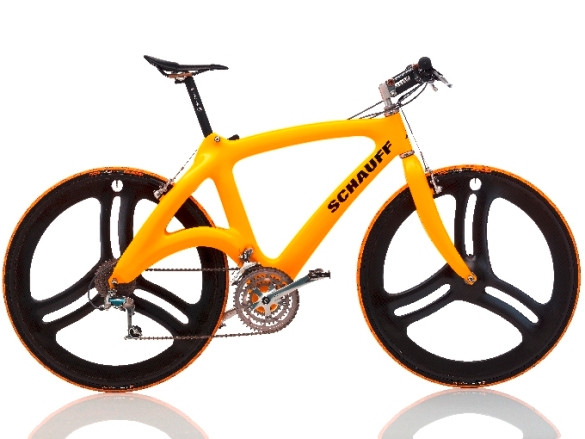When I was a child, I owned a Raleigh Chopper. I don’t suppose this will mean very much to anyone whose childhood started after 1982, but back then this was the absolute pinnacle of cool. It was canary yellow, with three gears and high handlebars and a reclining seat-back just like a Harley-Davidson. It was an absolute triumph of design, except in one small detail: the white strap that ran along the seat, with a warning along the lines of “This bicycle is not designed to carry passengers.”
I’ll return to this later.

Free Wheel, the new exhibition at the Design Museum in Holon, is all about bicycles: the history and the detail, the relationship between the most modest of transportation modes and the intricacies of design. It’s not so much that the bicycle combines form and function so effectively, but that rider scarcely notices. Therein lies the true beauty of the bicycle, I think: that it says so much with so little.
The curatorial team at the Design Museum, led by Galit Gaon, have put a lot of thought into creating a panoramic perspective of a design classic. The Collections Corridor, encircling the ground floor of the museum, provides an illustrated timeline of the history of the bicycle, interspersed with visual prompts and the occasional counterintuitive observation. Who knew, for instance, that the bicycle was a vehicle for female emancipation? Unlike horses, a woman could clamber atop without male assistance. In those more strait-laced times, it was unlikely that anyone other than a proprietorial husband or male relative would have helped in that task; the bicycle gave women the freedom to travel from place to place.
Interesting curios from the past, present and future of riding flesh out the trip through time. The folding BSA Airbourne bicycle – with an attached parachute – for instance, taken into battle by British paratroopers during World War Two, or the Hovding “invisible” bicycle helmet, which combines safety with the ultimate solution for helmet hair. (you can see a short demonstration video here http://vimeo.com/43038579.) The Design Lab continues along this theme, emphasizing the oft-invisible innovations that enhance bicycle design. From aerodynamic wind tunnels and 3D modeling to magnetic clip-on lights and a bike radio system that creates an acoustic bubble, dispensing with the need for headphones: design efficiency is inextricably embedded into the practice of making bicycles.
Downstairs, the Lower Gallery is given over to a trip into nostalgia: posters, models and fascinating films about the history of bicycle making in Israel. ICM, Dahar, Harash-Ofan and MCI, names that no longer resonate, but central from the 1930s onwards in the growth of bicycle culture in Israel.

The centrepiece, however, of Free Wheel is the impressive display in the Upper Gallery, 43 bicycles from the private collection of Michael Embacher. Embacher, an Austrian architect and designer, has over the last decade accumulated a collection of almost 300 iconic models from around the world and across time. The cross-section on display encapsulate the myriad influences that influence bike design: from the futuristic Bianchi C-4 project to the utilitarian Strida 1 commuter bike – via a replica of Francesco Moser’s record-setting bike, on which he managed to travel 50 kilometres in an hour – Embacher’s collection is both a labour of love and a celebration of design excellence. “Bicycles are the epitome of design effectiveness and aesthetics,” Embacher observes. “They capture my architectural ambitions…and they are healthy, good for the environment and fun!”
Which brings me back to my Raleigh Chopper, and its problematic white strap. The bike was really perfect, fun in every respect except for the wretched strap. It was like a red rag to a bull: it was only a matter of time before – in an attempt to impress my next door neighbour – I offered to give her a lift on the coolest bike on our street. I lost my balance after about five metres, and we ended up bruised and battered, her knees and my ego both. So much for design perfection.
Free Wheel continues at the Design Museum, Holon through 22nd March 2014, and is accompanied by a range of events for the family, including a bicycle school, an international conference on urban planning and cycling, a new Design Detectives trail for the younger design enthusiast, and a bicycle film festival at the nearby Holon Cinematheque. Further details and information at the Museum’s website, www.dmh.org.il





